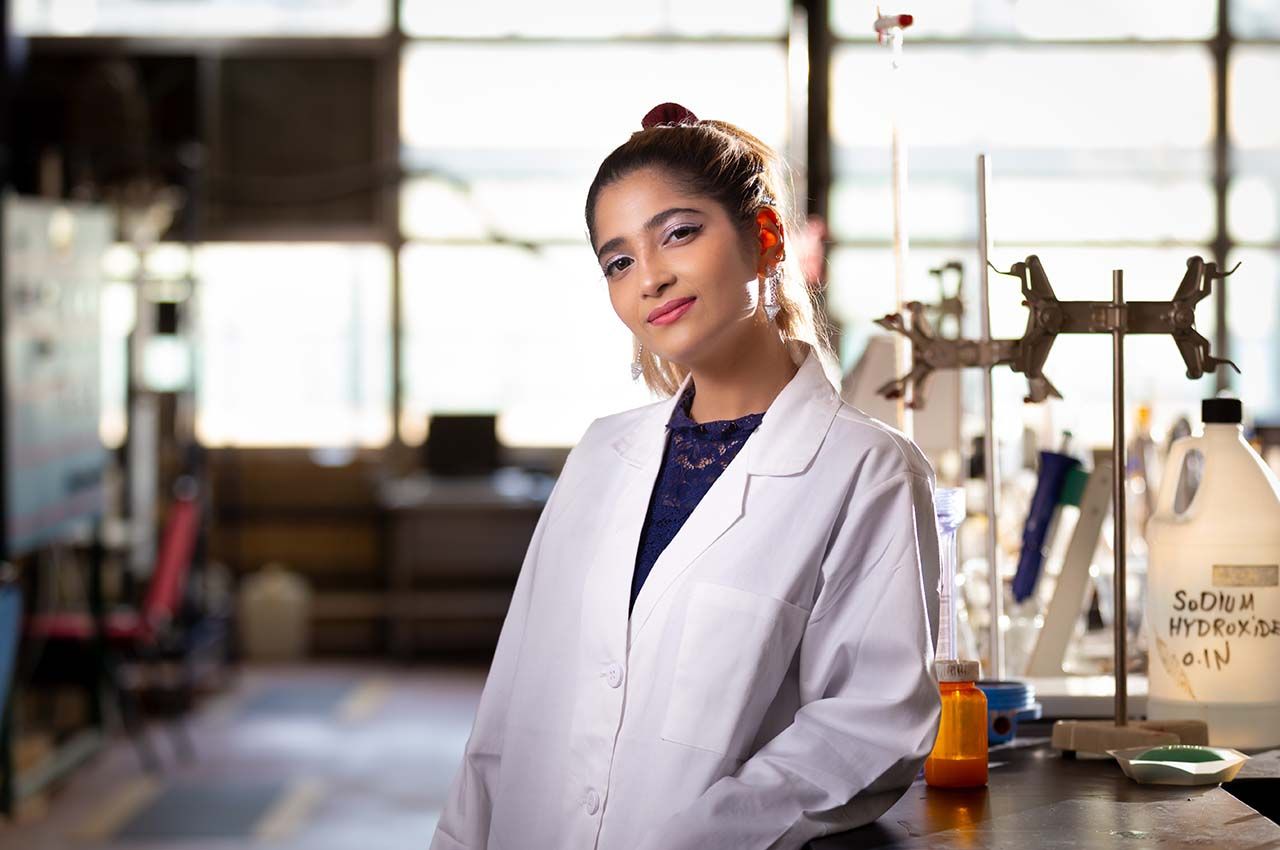From Hair Dye to Diabetes: A Path to Engineering Research

Pulkita Jain (CHE ’22) came to Illinois Institute of Technology to do research, with a particular interest in the health and pharmaceutical engineering fields.
Between Armour R&D, RES-MATCH, and elective courses, Jain has managed to participate in research every semester that she’s been at Illinois Tech.
Jain first found a love for research when she conducted a research experiment for a senior project in high school, finding the relationship between hair dye color and ammonia content.
“It helped me relate chemistry to everyday life. It made me very intrigued,” says Jain. “I think that was it for me.”
Jain moved from New Delhi to California, where she earned an Associate of Arts and Sciences in Physics, Chemistry, and Mathematics from Santa Barbara City College. But the closest she could get to research experience there was working in a chemistry stockroom.
“I enjoyed being in the lab, but I was interested in graduate school and knew that if I didn’t actually do any research, I would not know if I’m fit for a Ph.D.,” says Jain.
This brought her to Illinois Tech. In her first semester, her courses were online, and her parents tried to convince her to live at home with them in California. Instead, Jain moved to Chicago, hoping it would make it easier for her to get involved with research.
That semester she joined RES-MATCH, a research program for undergraduate students facilitated by the Pritzker Institute of Biomedical Science and Engineering.
She joined Research Assistant Professor Mudassir Rashid’s lab where she was tasked with analyzing glucose level data from real patients with diabetes and using that as the basis for a predictive model.
“It would be very helpful for someone who’s suffering from Type 2 diabetes because if your glucose monitor can tell you, ‘Hey, based on your glucose concentration right now, in the next 30 minutes you will go into a hyperglycemic episode [where the glucose level becomes too high],’ that’s helpful because then they can take insulin, walk around, or monitor how much carbs to eat depending on that,” says Jain.
Reducing the amount of time spent in hyperglycemia can have major long-term health implications as high blood sugar can cause damage to the eyes, kidneys, nerves, and heart, or even lead to a diabetic coma if left untreated.
Jain started the project with only minimal experience using the tools needed to create the model and initially found the process frustrating.
“At one point I reached out to Dr. Rashid and said, ‘Hey, I don’t know if I’m fit for this, it’s just not working,’ and he was able to help me look at his own process of what he does when he’s stuck on a problem,” says Jain. “I was able to take that and adapt it to what I was doing and to how my brain works, and that was great.”
Jain says now the challenges of overcoming the unknown have become her favorite part of the process.
“Sometimes things just don’t work, and you might not know why. Brainstorming by yourself, going to your professor, asking grad students, or even talking about my research to my friends brings the collaborative aspect. I am able to get input from so many people, and it’s incredible,” says Jain. “Also having to fail a couple of times was really interesting to me. I realized that I can persist. I think that’s where I probably developed the most resilience in my character.”
At the end of her semester of RES-MATCH, Jain had successfully created the model but wanted to continue developing the project. She applied for support through the Armour R&D program, which she went on to receive two semesters in a row.
She used this opportunity to build out the model to be more robust and include more features. This included estimating the magnitude of a hyperglycemia episode ahead of time to reduce false alarms such as when the glucose level would only touch the upper limit and then go back down
“In that case, we’d be sounding an alarm, and we tell you that there’s an episode, but there’s really not,” says Jain.
She also analyzed the accuracy of the alarms, implemented features that allowed the algorithm results to be personalized according to a person’s body composition and age, and integrated machine learning algorithms to potentially help speed the process.
Jain also adapted the model to detect when glucose levels become too low, resulting in a comprehensive product to help improve the long-term health and care for people with diabetes.
Jain says participating in a research group and working with graduate students helped her determine which skills to explore, which opportunities to seek out, and what graduate programs to apply to.
For example, a conversation with a graduate student helped her realize that she would benefit from wet lab experience, so Jain is spending her final semester at Illinois Tech working with S.C. Johnson Professor of Chemical Engineering Fouad Teymour and Professor of Biomedical Engineering Georgia Papavasiliou to develop an ointment to help patients with diabetes heal from wounds.
Now Jain is headed to a doctoral program at New York University. She’s particularly interested in projects that look to the community to identify problems that doctors, patients, or other people have where finding a solution could have a large impact in improving peoples’ lives.
“It's the concept of making a difference. If I do research, I might be able to invent or develop something that can be used by everybody, which just helps me reach more people,” says Jain.
Photo: Pulkita Jain (CHE ’22)




